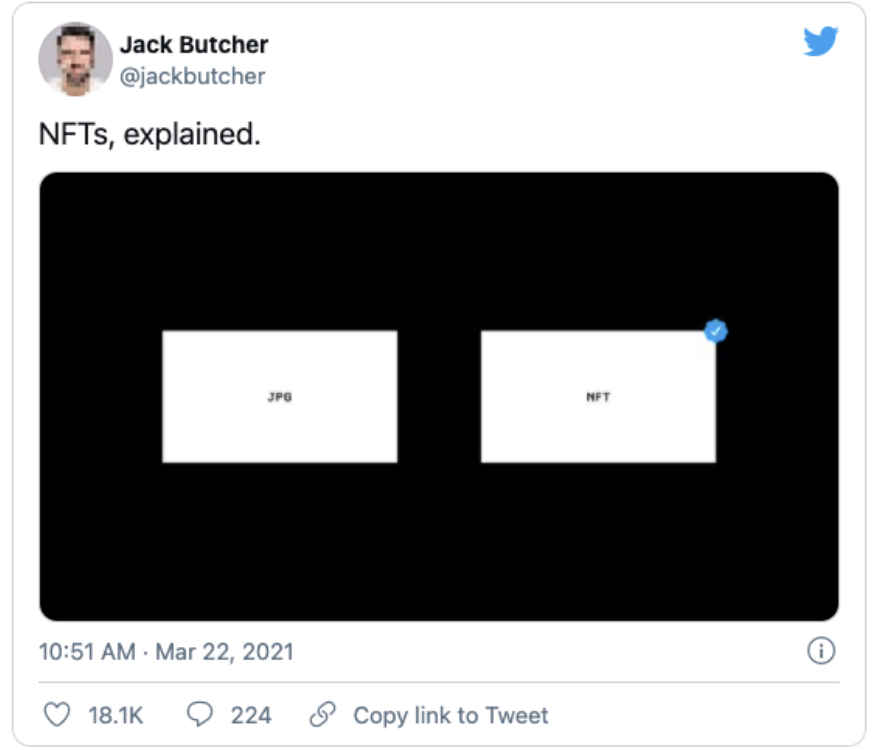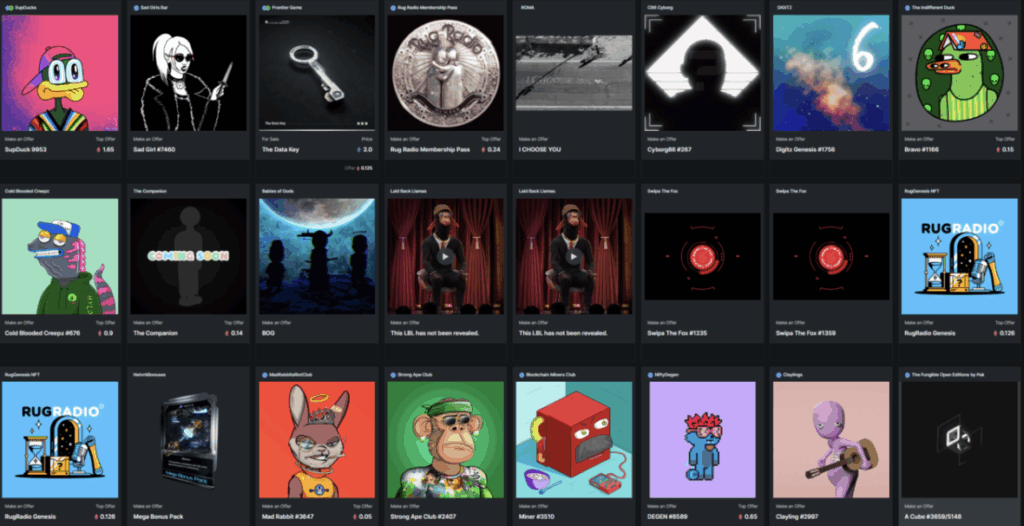NFT’s are revolutionizing the world with innovative technology in many industries, including the music industry. The first big spike of interest toward non-fungible tokens (NFTs) emerged from 2021 to early 2022. NFT trading volumes exceeded $44.2 billion in 2021 and continue to break records and reach new heights. With a good implementation, NFTs give artists control over their career by facilitating new revenue streams that completely bypass intermediaries.
It’s not a secret that over the last few decades, the music industry went through major changes, including the way people listen to and interact with their favorite musicians. As a result, all streaming services became the “go-to” point through which people listen to their favorite artists. However, with the introduction of NFTs, operative on the blockchain, the music industry’s opening up for a major turn. NFTs allow artists to verify ownership of intellectual property and artists distribute music across different platforms, and fans to own parts of music in return for an investment.
As we mentioned in the previous articles, the music industry works with royalties, meaning fee-based systems. Artists can earn through streaming royalties and public performances, as well as physical record sales. With the increasing implementation of the blockchain and NFTs, the music industry is continuing to build towards a place where musicians are more equitably rewarded for their work and are allowed more freedom in their creative and financial decisions. But what are NFTs exactly and what do they mean for the music industry?

We like to dive into this space and in this DaimoonMedia article, we’re helping you learn more about how the NFTs can change the music industry and what it can mean for you and your career. We’ll address some of the most pressing implementations, questions, and thoughts about the digital world of music and the blockchain.
What are Music NFTs?
First of all, it is good to note that “non-fungible” means that an item is unique and cannot be exactly replaced. NFTs provide a clear proof of ownership via blockchain technology and come with a certificate of authenticity that can be verified at any time by the blocks on the chain. Like crypto tokens, NFTs are stored in a distributed ledger, making them difficult to forge. In general, NFTs take form in different formats.
How Does It Work?
Music related NFTs know a variety of implications, such as copyright, audio, tickets and visual art. When done right, NFTs can allow artists to claim a large amount of control of their music project. For example, artists can release a unique set of works limited to public blockchains. In exchange for sharing the ownership and royalties of visual or sonic parts, artists receive a financial boost that can help them navigate their growth and marketing in today’s competitive market. Additionally, existing physical or digital assets on the blockchain can be “tokenized” as NFTs, generating another stream of income.
With many well-known artists rushing to join, the NFT music distribution space is becoming more and more popular. So, where do these NFTs live?
What is an NFT marketplace?
Let’s take a look at the concept of NFT marketplaces. An NFT marketplace is a decentralized application (dApp) that allows artists and fans to buy and sell their non-fungible tokens. Artists can, in a process referred to as “minting”, upload tracks and visual art to the blockchain. The platform headlining these developments is OpenSea, however there are enough alternatives, such as Rarible, Mintable and Nifty Gateway.

Outside of the different formats discussed before, you’ll find a secondary market for rare collectibles and other NFT music products. Fans can purchase these NFTs from the marketplace for personal use or resale. With Some NFTs it even goes as far as in-game use, exclusive and unusual items, and hands-on experiences such as artist meet-ups.. Therefore, these marketplaces play an important role in the lifetime of a music NFT.
How Fans Make NFTs Purchases?
Fans purchase the NFTs using cryptocurrencies. As most NFTs are currently living on the Ethereum network, the coin of a similar name serves as the main digital currency to pay with. Similar to anything on the blockchain, the chain will record which wallets possess ownership of specific assets.
A big advantage for artists is the ability to benefit any resales of the NFTs, meaning that artists will receive a percentage of the sales-price when one fan sells its ownership to another fan.
What Are The Different Forms Of NFTs In The Music Industry?
“Technology has always been a huge part of the music business and has defined how we make and consume music,” said Christine Robinson, Billboard’s music publishing reporter. It’s a good realization. If music follows technology, maybe we should as well? Proving this point, NFTs generated an impressive $25 billion in overall sales in 2021 and greatly expanded on all the different forms of usage.
Let’s take a look at a couple different ways NFTs have transformed the traditional way of music experience. If you dig deeper into what NFTs are enabling, it looks like they’re ready to define the future of music.
Songs And Albums
The most obvious use-case, you’d think, would be music. More and more artists are using NFTs to connect with their viewers by releasing exclusive songs and records and auctioning copyrights with their royalties in return for ownership. Artists such as Grimes, Shawn Mendes, The Weeknd, and many more have launched their versions of NFTs. For example, popular American musician 3LAU sold a tokenized album for over $11 million in February of 2022. He released 33 unique assets that assigned its buyers ownership over the music. The total sale made up for $11 million in 24 hours!
Other musicians such as Trey Songz, created an NFT Mystery Box, which includes unreleased new songs and exclusive music pieces composed by Trey Songz himself. He also included other rewards such as the opportunity to have video calls, and a once in a lifetime music co-creation with Trey.
Digital Artwork And Photos
This may include limited edition album covers, posters, and live performance photos. They can be licensed from a particular concert or record, or stand-alone created by the artist. We see a lot of collaborations happening on this front where artists bundle their forces with designers to team up for a unique end result.
Works of art play a major role in the artistic achievements of musicians and, to some extent, their income. For example, Lostboy’s NFT is a popular music collective that combines music and art, along with a focus on mental health.
Concert Tickets
The growing popularity of NFTs also creates practical real-life use cases, such as exclusive fan perks to access concert tickets before anyone else. For example, Kings of Leon became the first band to release an NFT album titled “When You See Yourself” in March 2021. The limited-edition release was offered with physical experience, including a lifetime bid for front row seats at the band’s show, and earned at least $ 2 million.
Merchandise
With the rise of NFTs, artists will have the ability to incorporate exclusive merchandise access to owners. To mirror that, you could even buy a t-shirt in the form of an NFT. You can acquire ownership of an exclusive digital, visual design of merchandise. In certain scenarios this allows you to pick up a real-life version of the t-shirt and have the NFT verify its authenticity. If you’re interested in this subject, make sure to peek at some fashion brands and their involvements with NFTs.
Song Teasers
Even though less popular but certainly not unimaginable, Mike Shinoda, a co-founder of Linkin Park, raised $30,000, auctioning a 37-second teaser of an unreleased song as an NFT. Sounds like a nice marketing budget.
Live Performance Videos
What’s cooler than turning your unique and special moments on stage into a unique item that true fans can own, instead of a file somewhere down your Instagram wall or Google Drive folder.
Expert TIP: NFTs, musicians and other creators do not have to relinquish ownership of content to the platform. When you publish an NFT, you can choose to waive the rights to the song or album, but in most cases you’ll want to retain ownership. That way, when you as a musician sell content, you get paid directly and more equitably. Secondly, if the current owner of your NFT decides to resell their NFT, you, the creator, will automatically receive royalties. This is all since proof of ownership is built into the NFT’s metadata.
Popular NFT projects like the Bored Ape Yacht Club are also being used to create new entry points into the music industry. In November, Universal Music Group formed a supergroup called KINGSHIP. Its members are four Bored Ape NFTs. Beyond NFTs, Universal Music Group has begun converting the entire artist list into digital avatars to bring music to the Metaverse.
To Wrap It Up
NFTs allow artists to receive alternative profits to their work. Releasing music as an NFT can often eliminate some unwanted intermediaries for artists. In return, their income will increase. As the music industry embraces the digital future, NFTs will continue to be part of the way artists and fans interact on Web3, from facilitating new music releases to acting as tokens for access to real-life experiences such as live events.
So in short, you might have started reading this blog with a vague idea about music NFTs. Through our article, we showed you what NFTs are and how they are helping artists and music professionals. Make sure to read our next blog and follow us on our social media channels. Moreover, feel free to ask us your questions to us on our Instagram (@daimoonmedia)!
FAQ
A digital collectible that proves ownership of a unique music-related item.
They create new income streams and give more control over sales and royalties.
Yes, especially when they include exclusive content or experiences.
No, they’re an additional way to connect with fans and earn money.
It can be affordable, depending on the platform and blockchain used.

